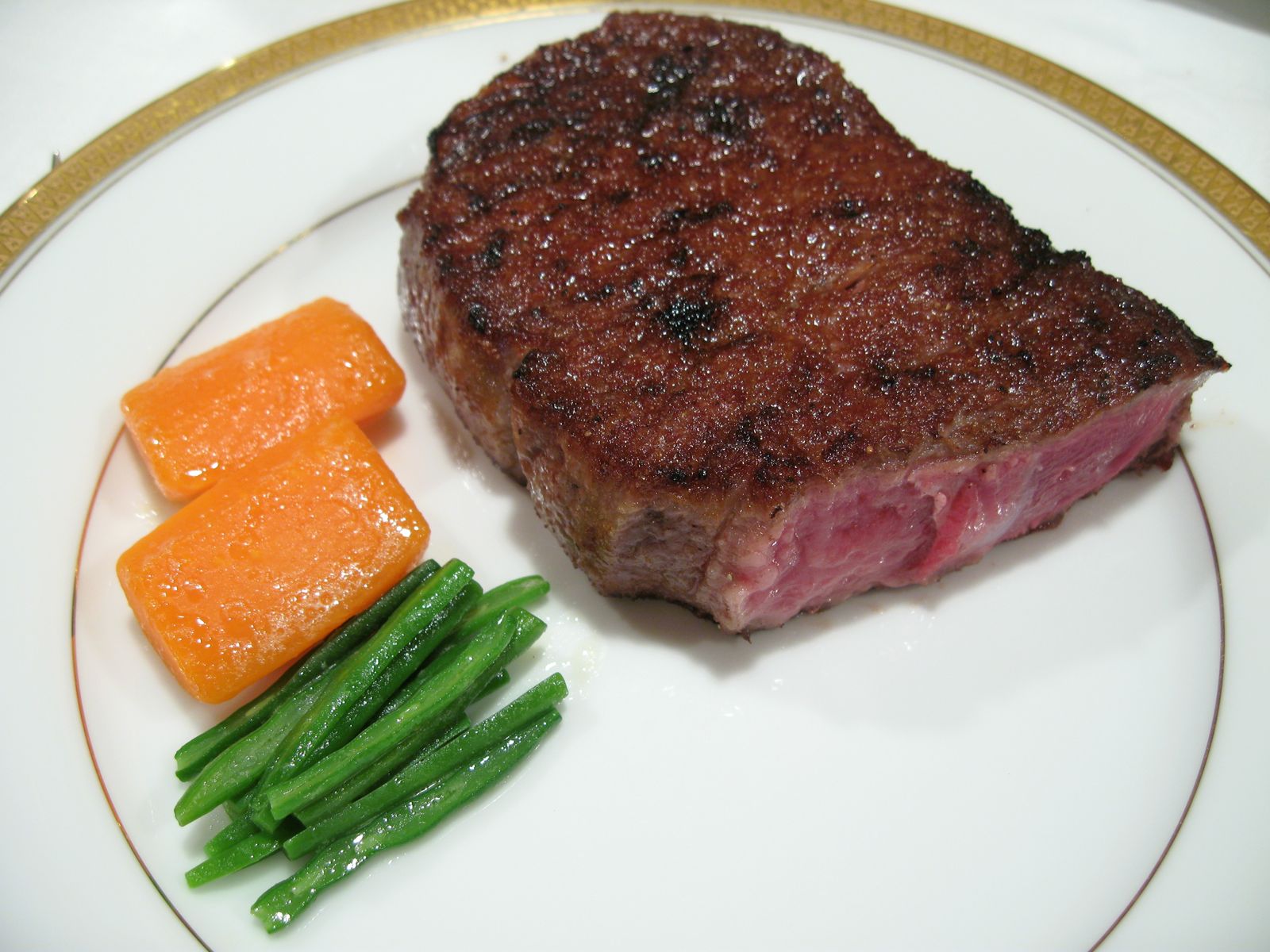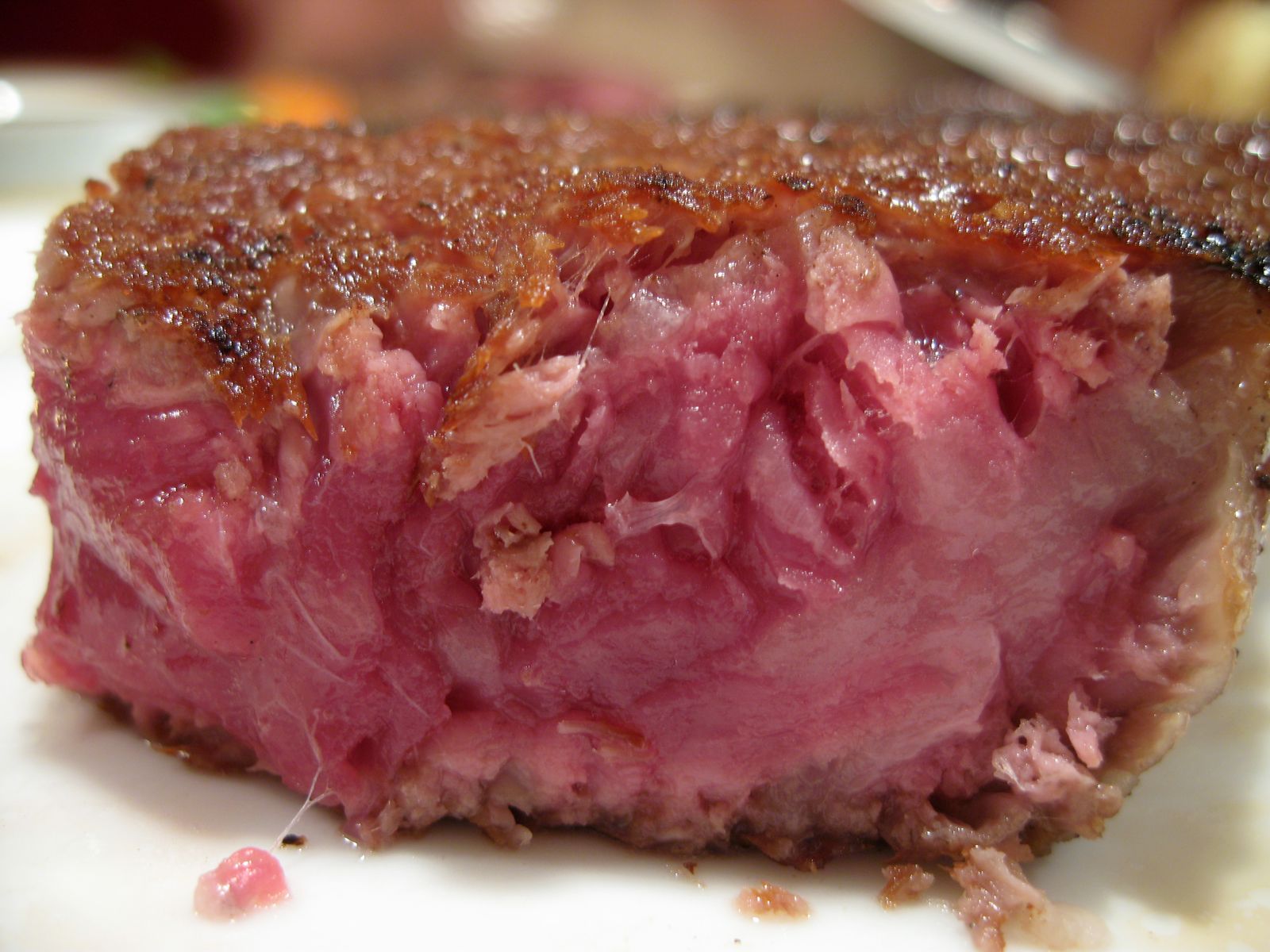Aragawa
Aragawa is certainly not known for its decor. As a restaurant located at the end of a dark hallway in the basement of an office building in Tokyo's Shinbashi business area, some might even claim that this restaurant is humble: there's certainly no grand entrance with valet parking. In fact, there isn't even an entrance. I would claim, however, that this only increases the restaurant's pretense. Like an exclusive club, the restaurant's location suggests that only a select few are lucky enough to know about what Forbes magazine called in 2006 the most expensive restaurant in the world. But prices aside, this basement retreat is known for something else: the juiciest, fattiest, and most tender Kobe beef in the world. Kobe beef is considered the holy grail of marbleized meats. As a process that involves regular massages and feedings of sake, raising wagyu is certainly no easy task. These cows are said to be treated fairly well, the theory being that happy cows produce better meat. Kobe beef is a specific name given to wagyu slaughtered in the Kobe region of Japan. Partly due to the manner in which the cows are raised, but mostly due to intentionally regulated low supply levels, this beef can get pretty expensive. Up to $800 a pound, in fact. The cows must also be slaughtered in Kobe, Japan for the title Kobe beef to be applied. During the mad cow disease scare just a few years ago, Japanese beef imports were restricted and so "Kobe style" beef was raised domestically in the US. The price was certainly less than the Japan imported counterpart, but purists would claim that there was a clearly noticeable degradation in quality. This distinction exposes a gray area for the cows that are raised outside of Kobe and are slaughtered in Kobe, since they're still technically considered Kobe beef. And that's what makes Aragawa special. It's affiliated with its own farm that both raises and slaughters its own beef in Kobe. No one argues that this beef is not authentic. And guests pay for that. So while both the wagyu and my wallet were massaged, there was some consolation in knowing that the price of the ingredients were partly responsible for the exorbitant prices. But despite knowing that this four figure dinner for two without alcohol did not contain highly marked up prices, I left feeling unsatisfied.
After arriving to the basement floor of an office building with all the lights off, I felt like I was about to engage in some kind of illicit activity. I walked past the closed office doors through what seemed like a sterile hospital ward when suddenly a Japanese man with slicked back hair popped out from around the corner announcing my name. (Wonder how he knew.) It seems I was in the right place. We were escorted through yet another closed door into a small windowless masculine room abundant with red and gold. I could practically touch the ceiling. There was no music, so my voice was quickly funneled into the awkwardness of silence; it was uncomfortable to talk. In a restaurant with about ten tables and an apparently large waiting list, only two others were full. To my left was a young couple from Singapore, the gentleman of which kept sniffling his nose which did nothing for the clearly visible trail of white powder his cold. To my right was an older man speaking Japanese with a significantly younger woman. Both couples seemed to engage in a staring contest with each other, and with my table. It was clear that a glass of wine was necessary. As I reached for my camera, a voice behind me whispered that photography was strictly prohibited. Yeah, ok.
It turns out that the gentleman with the slicked back hair was our waiter as well. He kind of pretended he didn't just bring us into the restaurant by welcoming us again. He swung around from behind me and handed me a sheet of paper with he pricings of the Kobe beef. This restaurant only serves Kobe beef; not the best place for vegetarians. There were two grades of beef, premium and super premium, both of which came in three different weights, 12, 16, and 20 ounces. We opted to split 16 ounces of the super premium beef, with my reasoning being that this is some fatty beef, and with fat weighing less than muscle, this would be a large steak. Our waiter then verbally explained the appetizer and salad options. Fresh chilled scallops sounded good; I didn't really want a salad.
While my glass of wine never came, my day boat scallops did instead, two large lightly boiled scallops served in the shell, the adductor still attached.The scallops were served simply with a wedge of lemon and a side of tomato based cocktail sauce being the only accompaniments. The large scallop was difficult to separate from the shell with my dull shell fish fork and butter knife being my only instruments. It was annoying because the scraping sound of the knife against the shell made me cringe. But once this slightly overcooked shellfish was separated from the shell, my appetite was whetted. Alongside the scallops came two slices of lightly toasted white bread with butter. Nothing special.
The waiter shortly returned holding a plate with our Kobe steak to show us before splitting in two. Looked pretty good to me, as I suddenly regretted not getting two individual twenty ounce cuts the portioning just about right for two people. The steak was split and returned, the beautifully rare burgundy steak glistening under the lights. The characteristic fat deposits of this beautiful Kobe steak were clearly evident as sheets of white embedded amongst the red. The juxtaposition of soft fat and tender muscle made cutting through the meat not only fun, but interesting as well. The resistance of the muscle held back the knife through the silky smooth slices of fat. This same texture was evident with every bite, the fat being squeezed out of the muscle creating a buttery taste. I asked for this steak rare; but I feel like the smoothness of the fat would have been even further amplified had this meat been cooked further, as the fat would have remained soft while the meat was made more tender. The steak was rubbed with salt and pepper, grilled, and served only with a side of mustard. It was delicious, particularly the flavor of the spicy mustard cutting through the juicy fat.
Next up was a promptly prepared bill and an offer for tea and coffee. That was it. No dessert. Nothing. We were in and out in just over an hour, making this without a question the highest price to time ratio for a meal I've ever had. We were never charged for the scallops nor coffee. Were these included in the price of the steak? I didn't want to ask in case they weren't. Shortly after, our waiter turned bell captain and escorted us upstairs to find a taxi. It was only eight o'clock, meaning there was time to stop off somewhere for dinner. I left that night a little hot under the collar, unsure of exactly what I was angry at. Was it the price? Perhaps; but in a culture obsessed with quality of ingredients, skill of preparation, and abundance of food, it's not uncommon to spend this kind of money on food in Tokyo. Was it the flavor? No; the steak was perhaps the most tender and certainly the juiciest piece of meat I'd ever had. Perhaps the service? It was definitely lacking; but nothing to go crazy about. I felt a little better the next day; but I still swore not to go back.
I think my problem was that unlike black truffles and beluga caviar, which even in the cheapest forms are still fairly expensive, there are inexpensive varieties of Kobe-style beef that may not have the exact same marbelization levels or come in 20 ounce slabs like Aragawa's beef, but certainly would fulfill any craving for fatty meat. So while I left upset, I realized that I was not upset at the restaurant so much as I was upset at having spent so much money on a single ingredient that comes in much cheaper varieties rather than a chef's skill. On the other hand, there was solace in knowing that this beef is expensive and profit margins for the restaurant may in fact be slim. I was also glad to have tried this beef to know for sure that there was no need to return.












